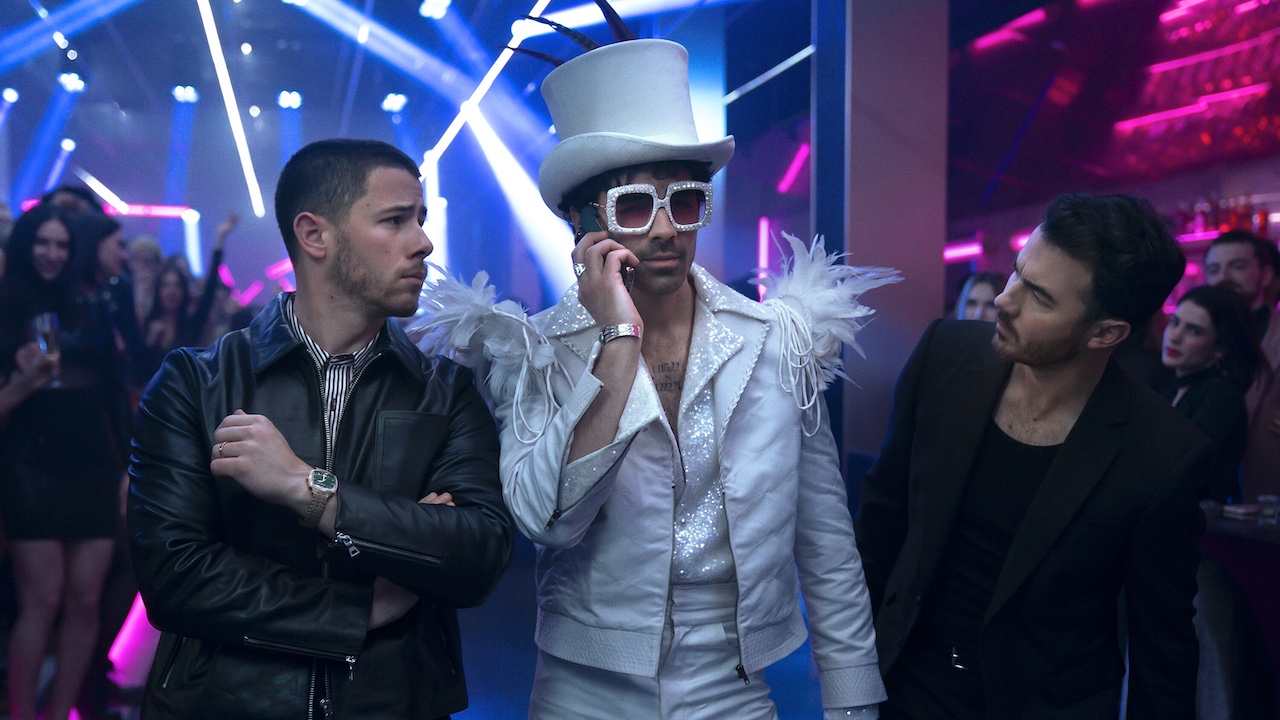HBO's Watchmen Episode 6: All The Big References To The Original Comic Book

CinemaBlend participates in affiliate programs with various companies. We may earn commission when you click on or make purchases via links.
Watch out! Major spoilers below for anyone who isn’t yet caught up with Watchmen’s latest episodes.
With its sixth episode, HBO’s Watchmen confidently wove its way into Alan Moore and Dave Gibbons’ comic book source material with stunning dexterity. The entire creative team created something truly transcendent for small screen audiences, from the direction to the editing to the music and so on. But we’re here to glorify the comic book references!
“This Extraordinary Being” took a step back from making plentiful comic book connections, at least in some ways, to completely shake up the canon while also answering some of the Watchmen TV universe’s lingering questions. It was a wild journey through time and space, thanks to Angela’s Nostalgia trip, but there’s no time like the present to dig in to everything we saw.
(If you haven’t gone back and read our previous comic book-centric Watchmen TV features, check out Episode 1, Episode 2, Episode 3, Episode 4, and Episode 5.)
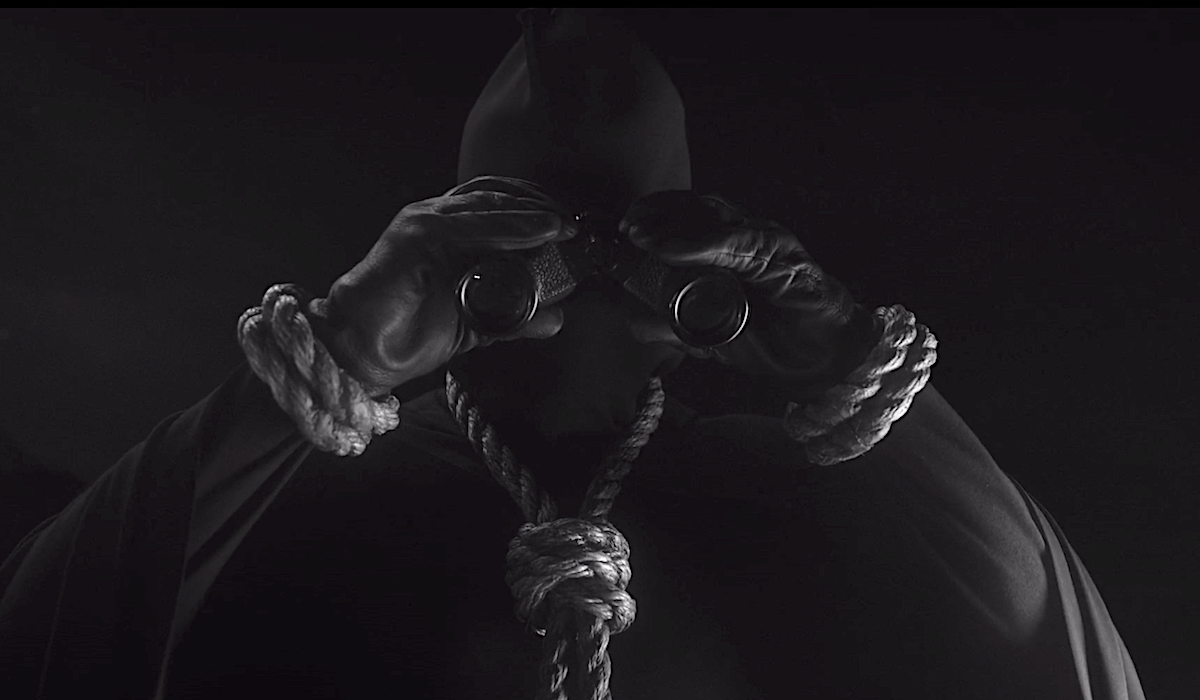
Hooded Justice’s Backstory
It feels necessary to start by pointing out nearly the entire runtime is devoted to giving Hooded Justice a TV-specific backstory that stays mostly faithful to the Watchmen comic while still twisting the heck out of it. That it started with American Hero Story’s familiarly heightened interpretation only served to remind comic viewers that there are more than enough blanks in the vigilante’s backstory that could be filled in interesting ways for TV.
We’ll get into more specifics as we go on, but it’s worth pointing out up top that episode writers Damon Lindelof and Cord Jefferson did play around with the mythos set up by Hollis Mason’s Under the Hood. As well, the opening interrogation scene loosely references the government's attempts to keep an official record of vigilante identities, something brought up in both Before Watchmen (with local police) and in Under the Hood (with Senator Joe McCarthy).
Your Daily Blend of Entertainment News
Watchmen Supervillains
The Seventh Kavalry currently serves as the most obvious overarching threat within HBO’s Watchmen, but the group definitely isn't this universe’s first batch of theatrical baddies. During the opening AHS sequence, a trio of comic-specific antagonists were mentioned as having been taken down by Hooded Justice and the Minutemen.
First was Captain Axis, a WWII Nazi operative who had a feud going with Nite Owl; Captain Axis was one of the villains that Hollis Mason visualized himself fighting whenever he was attacked by Knot-Tops in the eighth issue. The second name-check went to King Mob, a villain whose lone reference is an ape mask that appears in the background of the scene when The Comedian assaults Silk Spectre.
The third villain mentioned is the most prominent of the Watchmen comic foes: Moloch the Mystic, real name Edgar Jacobi. Moloch kept up his criminal activities from the 1930s through the 1970s before retiring and unwittingly becoming part of Adrian Veidt’s anti-Doctor Manhattan scheme. Veidt first ruthlessly gave Moloch cancer and later shot him in the head after The Comedian’s drunken visit, a murder that Rorschach was framed for. Fingers crossed we still get a memorable Moloch scene in a future episode's flashback.
The Importance Of Titles
Considering “This Extraordinary Being” is such a semi-revisionist take on one of Watchmen’s most curious vigilantes, it’s only fitting that the sixth episode’s title come from the source material itself. On page six of Under the Hood, Hollis Mason used the description when talking about Hooded Justice’s supermarket incident:
This extraordinary being had crashed in through the window of the supermarket while the robbery was in progress and attacked the man responsible with such intensity and savagery that those not disabled immediately were only too willing to drop their guns and surrender.
Those words tell a different story than the one seen later in the grocery store. Perhaps it’s because Hollis Mason’s autobiography was rife with sections that were given major overhauls prior to publication, due to sensitive material. Or perhaps it was because the incidents were completely different.
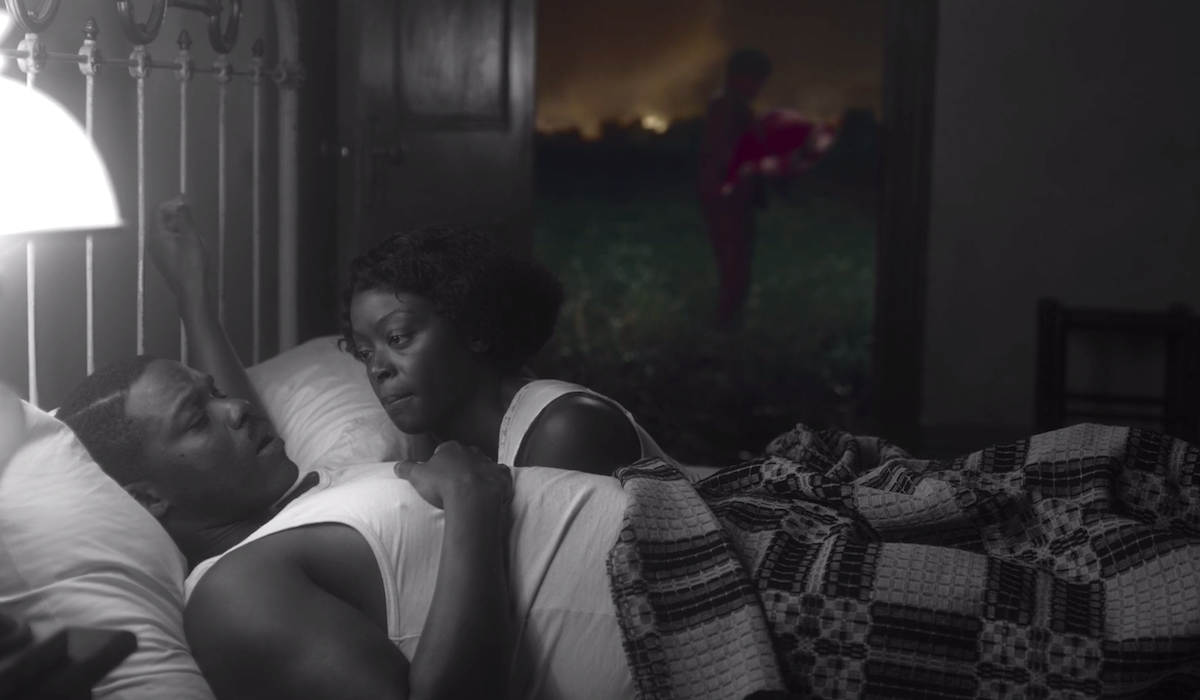
Watchmen’s Use Of Color
Not that HBOs Watchmen hasn't delivered many color-focused moments in its five previous episodes, from Tulsa PD's signature yellow masks to that sporadic blue glow. "This Extraordinary Being" went above and beyond, however, in offering up a color scheme that truly stepped up to the work of the Watchmen comic book's colorist John Higgins, though not in ways that mimicked Higgins' palette. Instead, Watchmen bounced between the black and white tones of Will Reeves' adulthood and the other more colorful stages of his life, while also combining them in lovely ways, such as the bedroom scene where the pilot flashback played out through an open doorway.
In particular, it's the episode's use of the color red that is the most striking and enigmatic. Will's piano-playing mother, the bodies being dragged behind the cop car, and the red light over the recording room door were haunting reminders that these overlapping memories were happening inside Angela's mind. Those moments brought to mind another visually unique comic book adaptation, Robert Rodriguez's Sin City, just with a completely different emotional through-line. (For those who haven't read Watchmen without John Higgins' colors, check out the black-and-white release Watchmen Noir.)
Newspaper Vendor
The corner newspaper stand in 1938 clearly wasn't still standing in Watchmen's 1985 setting, but its presence was just as clearly meant to mirror the use of newsstands in this universe. Not only in the way that headlines drew focus, but also because it set up a very important moment that we'll talk about next. Also note that the stand was centrally located in front of a store selling watches. Tick-tock.
Action Comics #1
In Watchmen's world, the rise of superhero comics didn't take off the way they did in the real world, largely due to the rise of costumed vigilantes that made up the Minutemen, but the Watchmen TV show brought in arguably the most important comic book of all time. Action Comics #1, which featured the first appearance of Jerry Siegel and Joe Schuster's iconic hero Superman, was shown to Will by the news vendor at precisely the right moment to influence Hooded Justice's arrival. The scene also vindicated anyone who'd mentally connected Will's childhood trauma to Superman's comic origins.
Within the Watchmen text, Superman's first appearance was most prominently viewed through Hollis Mason's eyes via his Under the Hood biography. Though he initially pegged the comic to be for children, the future Nite-Owl was quite taken by the wholesomeness of Clark Kent in the face of darker stories told in The Shadow. He may not have been quite as immediately inspired by Action Comics the way that Will was, but there's no question how influential the Man of Steel was for all iterations of Watchmen.
Hooded Justice’s First Appearance
The Watchmen comic book never fully delivered an explanation for Hooded Justice's rope-laden costume, but Damon Lindelof & Co. figured out a pretty brilliant way to weave Will Reeves' tragic story into the information provided by the source material. "This Extraordinary Being" explored Will's challenging run as a New York City cop at a time when black cops were intentionally few and far between, which was definitely a different experience from Hollis Mason's time as an NYC cop in the late '30s. (One wonders if they ever crossed paths on the job.)
After being taken to the brink of death by his Cyclops-minded fellow officers, a mentally broken Will walked home with a noose around his neck when he heard a violent mugging in progress. That's when the hood went on and the animal was unleashed for the first time. The events didn't play out precisely as they did in Hollis Mason's account in Under the Hood – for instance, Will's Hooded Justice hadn't "dropped into the alleyway from above" – but contradictory witness reports were indeed key to the vigilante's continued mystique.
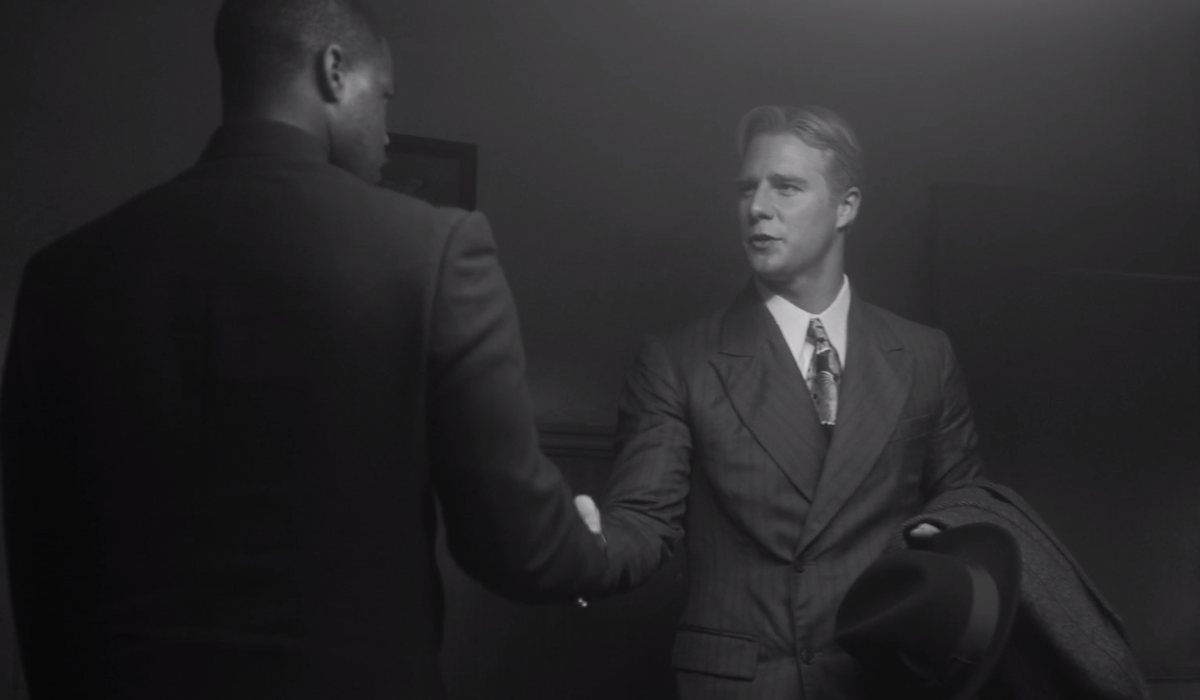
Captain Metropolis' Introduction
Watchmen viewers had previously been introduced to the "fictional" version of Captain Metropolis through American Hero Story's risqué sex scene, but Episode 6 brought in the "real" Minutemen leader via Jake McDorman's Nelson Gardner. Contrary to how things were (admittedly vaguely) presented in the comic book, Nelson did indeed see Hooded Justice sans hood, and that's actually how they first met. And contrary to the aforementioned sex scene, the two vigilantes were not in costume when they started their illicit affair.
Much as the comic character was presented as self-involved and interested more in spotlight-grabbing than in bringing down all forms of crime, the TV take on Nelson Gardner's Captain Metropolis was an image-conscious hornball whose tolerance of Will's skin color didn't extend beyond the bedroom. It'd be kind of a shame if this is all that TV audiences see of the nationally renowned Captain Metropolis, but it wouldn't be so surprising.
Clocks, Clocks, Clocks
Everybody knows that clocks are an extremely important visual motif within Watchmen, and Episode 6 expectedly featured a handful of timely appearances. Perhaps the most important and/or interesting was the clock shown during the Minutemen's photo shoot, which will be discussed more below. That moment happened around 11:55 (presumably a.m.), and its closeness to the 12 o'clock hour was likely tied to the mental stress that Hooded Justice was feeling about his Cyclops investigation being ignored by the others.
Interestingly, the sequence in which Will tried to get that pompous arsonist arrested showed viewers clock times that seemed to contradict each other. The clock in the precinct initially read roughly 6:17, and when Will goes outside and talks to the news vendor, the watch shop's clock shows that it was around 8:18. But then when Will returns to complain about the arsonist going free, the precinct's clock pegs the time as 7:27 or so. It would be a lot easier to write that off as a continuity error if Watchmen wasn't so finely tuned with its time-related details, so did that mean anything?
Nazi Rally At Madison Square Garden
Considering Watchmen's storyline was more connected to the Vietnam War over World War II, the subject of Nazis didn't often come up. (As hinted at earlier, the Minutemen villain Captain Axis made only the slightest appearance in the source material.) The TV show's themes of prejudice and xenophobia make it a more suitable home for Nazi-esque elements, however, and one particular bit of set dressing stood out to me as a potential comic book parallel.
One of Will's Cyclops-infused articles referenced the Nazi rally held at Madison Square Garden in February 1939. The real-world event attracted upwards of 20,000 people, but didn't do much to spread the rise of Nazi sympathizers in the U.S. Though it's obviously not a direct tie-in, Madison Square Garden was the ominous setting for Pale Horse's final concert on the night of the Squid catastrophe. There have long been debates over how heavily the band influenced the rebellious and sometimes deadly Knot-Top gang that shared the lead singer's hairstyle, so perhaps this was Damon Lindelof connecting those dots in the haziest way.
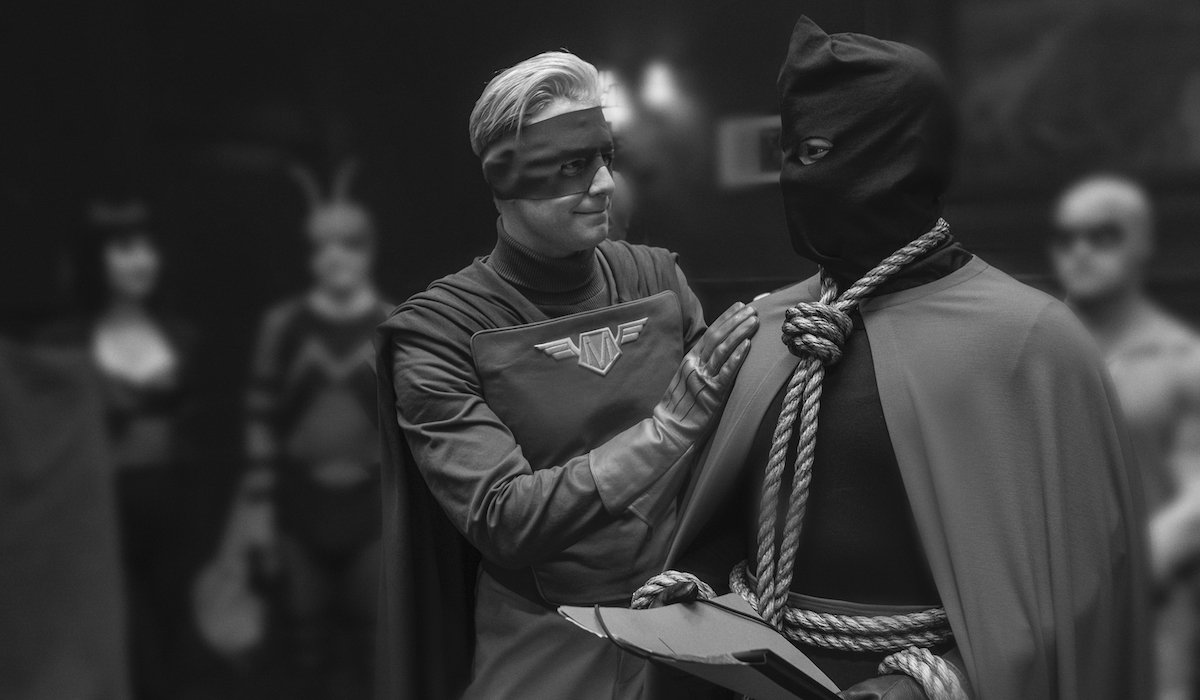
The Minutemen Photo Shoot
The comic's oft-used photograph of Jon and Janey' amusement park date is only eclipsed in importance by the group shot of the Minutemen, in which all the major players were present. HBO's Watchmen paid tribute to that moment in Episode 6, but in a smart way that didn't necessarily depict THE photo held so dear by Hollis Mason, Sally Jupiter and others. It's not so clear how many promotional pics the Minutemen took during their heyday, but it's possible there were some less impressive ones beyond that iconic shot.
The parallels were definitely there, though, minus the Cyclops folder that Will Reeves was holding onto throughout. The background characters' features intentionally obscured by blurriness, but the other Minutemen members were still easily recognizable, and they were seemingly lined up in the same order as the Watchmen group pic: Silhouette, Mothman, Dollar Bill, Nite-Owl, Captain Metropolis, Silk Spectre and then Hooded Justice, with the 16-year-old Comedian kneeling in front of everyone.
Reflective Storytelling
Similarly to how Episode 5 directly mirrored Watchmen's palindromic fifth issue, the sixth installment featured some equally giant emulative reflections that honor Alan Moore and Dave Gibbons' textured narrative and artwork. These happened most notably through Will's Hooded Justice exploits, which were foreshadowed via those slightly off-base American Hero Story scenes. The alterations made to Hooded Justice's origin story – from the original comic to the TV show to the dramatized show-within-a-show – are a sign of the way mass media largely embraces sensation over strict reality, at least in my mind.
For instance, Hooded Justice's big act of grocery store heroism, which was depicted in both the comic's Under the Hood excerpts and in the first big American Hero Story segment, got turned on its head in Episode 6. Like the photo shoot, this could have been a different incident entirely, since Hooded Justice was busting some KKK skulls at the time and not stopping a robbery; they were definitely meant to be connected, though, given the opposing front-window crashes. That said, this may have been a case where authorities skewed the story to the papers in order to draw less attention to the Klan being around.
With such important moments gluing our eyes to the screen throughout the episode’s runtime, it’s more than possible that we didn’t mention a fairly major comic book connection that struck others as important. I’ll cop to that, but be sure and let us know in the comments what other Watchmen comic homages you saw.
One Watchmen Film Star Is 'Loving' Damon Lindelof's HBO Series
Watchmen airs Sunday nights on HBO at 9:00 p.m ET.

Nick is a Cajun Country native and an Assistant Managing Editor with a focus on TV and features. His humble origin story with CinemaBlend began all the way back in the pre-streaming era, circa 2009, as a freelancing DVD reviewer and TV recapper. Nick leapfrogged over to the small screen to cover more and more television news and interviews, eventually taking over the section for the current era and covering topics like Yellowstone, The Walking Dead and horror. Born in Louisiana and currently living in Texas — Who Dat Nation over America’s Team all day, all night — Nick spent several years in the hospitality industry, and also worked as a 911 operator. If you ever happened to hear his music or read his comics/short stories, you have his sympathy.
